Guilin, where the fable beginsPrepared by Harold Stephens
Travel Correspondent for Thai Airways International
When the name China is mentioned, certain pictures come to mind. Most always, and foremost, is the Great Wall of China, and then perhaps it’s the Forbidden City or the Temple of Heaven, both in Beijing. But those images we have of China are not necessarily sites. There can be, for example, Chinese scrolls and paintings. The most memorable ones are those of sharp peaks and pinnacles that rise up abruptly from deep valleys and are bathed in clouds and mystery.
We accept those images of the Great Wall and the temples as being real, genuine. But when it comes to the scrolls and paintings, that becomes another matter. They are true Chinese, and we agree to that, but they are creations from the minds of artists and poets. The subject matter, we are lead to believe, is not real. How can they be? Some look almost abstract. That’s what we may believe until we visit Guilin in Southern China. It is then we come to the sudden realization that those scrolls and paintings are not products of anyone’s imagination. They are real, genuine. Guilin is the fabled beauty of China that is alive.
Situated on the bank of the Li River, some 515 km (320 miles) northwest of Hong Kong, Guilin is one of China's most famous beauty spots. The river and limestone peaks of the surrounding area bring to life the classic scenery celebrated on Chinese scrolls and paintings. Guilin ranks as one of the country's top five tourist attractions because of its scenic beauty, thanks to the limestone monoliths and for the Lijiang River (more familiarly known as the Li River).
Guilin itself is an ancient city, founded in the 3rd century B.C. when the first Qin emperor built the nearby Ling canal to link the Yangtze and Pearl River systems. Capital of Guangxi Province from the Ming Dynasty to 1914, Guilin today is a regional center of manufacturing with a population of 300,000.
It's worth spending a day strolling or cycling around Guilin to become orientated. Most of the city lies on the western bank of the Li River. The main artery is Zhongshan Lu, which runs roughly parallel to the river on its western side. The street itself is a rapidly developing stretch of tourist-class hotels, opulent department stores and expensive restaurants, and a good place for browsing.
Jiefang Lu runs east-west across Zhongshan Lu. Heading east, it runs over Liberation (Jiefang) Bridge to the large Seven Star Park, one of the town's chief attractions. Most of the limestone pinnacles form a circle around the town, though a few pop up within the city limits. The centre of town is not that attractive, and it’s where the industry and business are located.
But it’s the beauty and not the industry that attracts visitors. There are, actually, several steep but climbable crags jutting right out of the center of town. For the best views of the surrounding karst formations you either have to climb to the top of these hills or get out of the town altogether. The peaks are not very high and are often obscured by the buildings, but good views can be had from the top of most hotels, which could be the hotel where you are staying.
Solitary Beauty Peak is a 152-metre pinnacle in the centre of the town. The climb to the top is steep, some 306 steps, but there are good views of the town, the Li River and surrounding hills. The nephew of a Ming emperor built a palace at the foot of the peak in the 14th century, but only the gate remains.
Close to Solitary Beauty and standing beside the western bank of the Li River, is Wave Subduing Hill that offers a fine view of the town. Its name is variously described as being derived from the fact that the peak descends into the river, blocking the waves, and from a temple that was established here for a Tang-Dynasty general who was called Fubo Jiangjun, the wave-subduing general.
On the southern slope of the hill is Returned Pearl Cave. The story goes that the cave was illuminated by a single pearl and inhabited by a dragon; one day a fisherman stole the pearl but he was overcome by shame and returned it.
Fubo Hill, beside the river, offers a similar panorama, as well as Tang and Song Buddhist carvings in the caverns that riddle its base.
Some of the most extraordinary limestone scenery is underground. Reed Flute Cave is the best, with chamber after chamber of stalactite and stalagmite clusters, luridly (some would say magically) lit. The most extraordinary scenery Guilin has to offer is underground. If you see nothing else then try not to miss the Reed Flute Cave in Guangming Hill about five miles northwest of downtown. It has more than a thousand-year-old history. A tour of the cave, some 1270 metres deep, takes an hour. The cave is so large the main grotto can house a thousand people at any given time. Fortunately the inside of the cave is illuminated with electric lighting which transforms the incredible shapes of stalactites and stalagmites into vibrantly coloured flowers and fruit, mythical beasts and delicate draperies.
The Chinese have given the various sights lyrical names. The eerie under-ground extravaganza they call "The Art Palace of Nature." There’s no escaping the steady sound of dripping water. The ghostly stone pillars give the appearance of frozen fish, lions, flowers and fruit. The Chinese have named them all: Morning Sunrise Over the Lion Jungle, Cloudy Mountain Outside the Window-Curtain, Round Top Mosquito Net and more. Others are Big Belly Buddha, and Crystal Palace of the Dragon King.
For those travellers with limited time I would suggest a night excursion on the river to watch a cormorant fisherman, one of the remarkable experiences awaiting the traveller to Guilin.
Cruise boats carry up to a hundred passengers. Towed alongside the boats are long narrow rafts of bamboo. At the bow of the rafts are lanterns, which, when lighted, send out bright beams of light. These lights are to attract the fish. Trained cormorants are tethered to the rafts with cords tied around their necks to prevent them from swallowing any big fish. The fishermen actually call out commands, while the long-necked cormorants crouch and stare into the water. Suddenly, their heads would disappear below the surface, and in seconds they would emerge with great fat fishes flapping in their beaks. The fishermen at this point slam the water with their poles at which the cormorants return to the raft. The fishermen then remove the fish from their beaks which they place into large reed baskets. It’s a sight that’s well worth seeing.
Guilin's top tourist attraction is the Li River Cruise, through some of the most scenic country seen anywhere in China. Most excursions cruise 84km (52 miles) down the Li River to Yangshuo from which it’s possible to return to Guilin by road. From the boat there are some great views of the countryside that slowly passes by: Children splashing in the waters; platoons of white ducks paddling leisurely in circles; farmers with water buffaloes tending their fields. There are endless pagodas, gushing waterfalls and groves of graceful phoenix among a tall forest of bamboo that line the banks. The river is alive with a flotilla of other boats and sampans.
Another site that is remarkable is Elephant Trunk Hill, so named because it resembles an elephant drinking from the river. It’s on an island just south of town and can be seen from the roof of most hotels. It’s a celebrated landmark in Guilin. At the river's edge is the entrance where a prominent rock extends out over the hill and arches into the Li River, resembling a huge 260-metre-high elephant. The round, open cave between the trunk and the legs is called Moon in Water because, at night, it looks like a silvery moon is rising from the surface of the water.
Guilin is a mood; it’s also a destination of great beauty and one you won’t easily forget. But then, as time passes, you might wonder if it wasn’t your imagination and not a real place. Guilin can do that to you.
Harold Stephens
Bangkok
E-mail: ROH Weekly Travel (booking@inet.co.th)
Note: The article is the personal view of the writer and does not necessarily reflect the view of Thai Airways International Public Company Limited. | 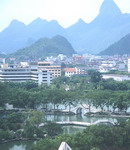
Guilin, one of the neatest cities in China | | 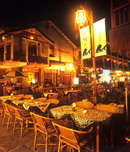
And great places to dine | | 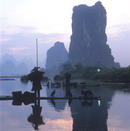
Southern China, a land of mood | | 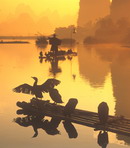
Follow the legend | | 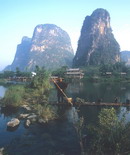
The hills rise up like magic | | 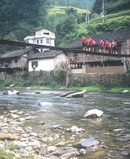
Swinging bridges cross the rivers | | 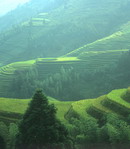
Man made beauty in rice terraces | | 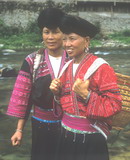
Hill tribe girls smile for the camera | | 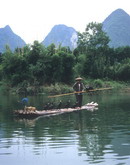
Transportation is by rafts | | 
Tourists enjoy raft trips too |
|





